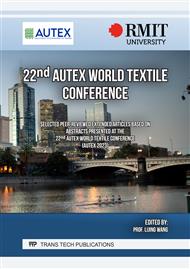p.11
p.21
p.27
p.35
p.43
p.55
p.63
p.69
p.79
Influence of Linear Density of Polyamide Plating Yarn on the Usage and Comfort Properties of Men’s Cotton Socks
Abstract:
Socks, being a necessary item of clothing, must be comfortable and maintain their quality throughout their life. Therefore, it is very important to select the yarns for their production. Usually, casual socks are made from a high percentage of cotton to ensure softness and comfort, and blended with polyamide to improve fit, durability and shrink resistance. The objective of this study is to compare five groups of black colored cotton calf-length men's socks produced under the same conditions in full plating with different textured polyamide 6.6 multifilament yarns, designated as: 22 dtex f7 × 2, 33 dtex f10 × 2, 44 dtex f13 × 2, 78 dtex f23 × 2, 110 dtex f34 × 2. The influence of the linear density of the polyamide plating yarn on the usage properties of the socks was evaluated by testing abrasion resistance and propensity to surface pilling with the Martindale abrasion and pilling tester, dimensional stability and color fastness to washing, perspiration and rubbing, as well as on comfort-related properties by testing moisture absorption, air permeability and thermal resistance with the Thermal foot manikin system. In addition, the basic physical properties of the socks, consisting of density parameters, mass and thickness were measured, all according to the standardized test methods. The results show that increasing the linear density of polyamide 6.6 yarns (i.e., increasing the amount of polyamide in the socks) has the following effects: increase in mass, thickness and structural change of sock plain knits, increase in abrasion resistance and change in dimensional stability of socks, decrease in moisture absorption, air permeability and thermal comfort of socks. From the obtained results, it can be concluded that when selecting the plating yarn for the production of cotton socks, it is necessary to take into account their linear density and structure, as well as the intended purpose of the socks, their specified comfort and the expected usage quality.
Info:
Periodical:
Pages:
43-53
Citation:
Online since:
March 2024
Keywords:
Price:
Сopyright:
© 2024 Trans Tech Publications Ltd. All Rights Reserved
Share:
Citation:



